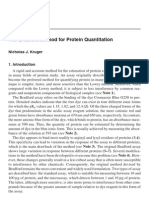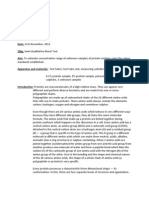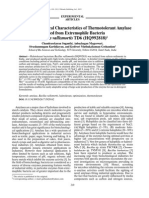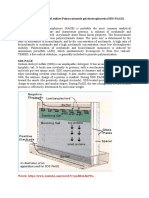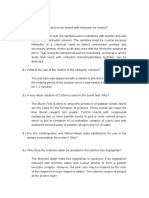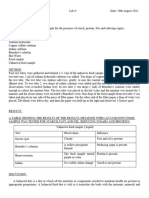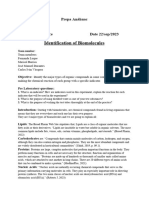Lab Report Exp.6
Lab Report Exp.6
Uploaded by
Qj B PdkhCopyright:
Available Formats
Lab Report Exp.6
Lab Report Exp.6
Uploaded by
Qj B PdkhCopyright
Available Formats
Share this document
Did you find this document useful?
Is this content inappropriate?
Copyright:
Available Formats
Lab Report Exp.6
Lab Report Exp.6
Uploaded by
Qj B PdkhCopyright:
Available Formats
SBM 1013 BIOCHEMISTRY1
LAB PRACTICAL 6
PROPERTIES OF PROTEINS AND AMINO ACIDS - QUALITATIVE TESTS
Name Matric No. Section
: Siti Fatimah Azzahrah bt Roslan : 0616996 :2
Date of Submission : 24 August 2006
Siti Fatimah Azzahrah bt Roslan BSBM
0616996
Section 2
Lab Report Experiment 6 Properties of Proteins and Amino Acids Qualitative Tests Introduction Proteins are extraordinarily complex molecules. Complete models depicting even the smallest of the polypeptide chains are almost impossible to comprehend. Biochemists have distinguished several level of the structural organization of proteins. Primary, structure, the amino acid sequence, is specified by genetic information. As the polypeptide chain folds, it forms certain localized arrangements of adjacent amino acids that constitute secondary structure. The overall three-dimensional shape that a polypeptide assumes of called the tertiary structure. Protein that consists of two or more polypeptide chains (or subunits) are said to have a quaternary structure. On the basis of composition, proteins are classified as simple or conjugated. Simple proteins, such as serum albumin and keratin, contain only amino acids. In contrast, each conjugated protein consists of a simple protein combined with anon-protein component. The non-protein component is called prosthetic group. ( A protein without its prosthetic group is called an apoprotein. A protein molecule combined with its prosthetic group is referred to as a haloprotein). Prosthetic groups typically play an important, even crucial, role in the function of proteins. Conjugated proteins are classified according to the nature of their prosthetic groups. The objectives of this experiment are to identify proteins from the samples given, to investigate the properties of proteins and amino acid, and also to perform the qualitative tests of proteins and amino acids accordingly. Method To perform this experiment, we have been provided with five samples, labelled A,B,C,D and E, and we were required to perform a total of seven tests on each sample. First, all the test tubes were labelled as A, B,C,D and E, and 0.5ml of each sample was transferred to its appropriate test tube. For Biuret test, 0.5ml of Biuret reagent was added to samples and the observations were recorded. Next, in Xanthoproteic acid test, 5 drops of concentrated nitric acid was added to each sample. Then, the test tubes were heated in boiling water bath for 3-4 minutes and the observations were recorded. After that, the tubes were cooled and 25 drops of 3M NaOH solution were added to change the pH to slightly alkaline. Any changes were again recorded. This test must be performed in the fume hood. The third test which was Ninhydrin test was conducted by first adding 0.1ml (2-3 drops) of 2% ninhydrin solution to samples. The tubes were then swirled and observations were recorded. Next,the test tubes were heated in a boiling water bath for about 2 minutes and any changes that occurred were recorded. Cyteine test was done by adding 5 drops of 3M NaOH and 2 drops of 1% lead nitrate. After that, the tubes were heated for 5 minutes in a boiling water bath and the observations were recorded. In protein
Siti Fatimah Azzahrah bt Roslan BSBM
0616996
Section 2
denaturation test, 5% sodium chloride was added to each sample and the tubes were heated in boiling water for 10 minutes and the observations were recorded. The sixth test was precipitation with acid anions. For this test, 15 drops of 2% trichloroacetic acid (TCA) was added to samples and the observations were recorded. The last test was precipitation with heavy metal ions. 15 drops of 2% copper sulphate solution was added to each sample, then the contents were swirled and the observations were recoded. Lastly, 3 drops of 0.1M sodium hydroxide was added to tubes, swirled, and any changes were recoded. It was difficult sometimes to identify the precipitation as its formation was in very small amount. Results (Please refer Table 1) Discussion This experiment was done by performing seven tests on five different samples which were labelled as A,B,C,D and E. We started with Biuret test which is the general test for the presence of protein. The Biuret reagent from this test consists of CuSO4 in NaOH solution. If the Biuret reagent is added to protein under the copper (II) it will form a colored complex with peptide bonds from the protein. The blue reagent turns violet in the presence of protein, and changes to pink when combined with short-chain polypeptides. From the results, sample C and D turned the blue solution into violet. Therefore, it is known that only sample C and D are proteins among all the five samples. These samples are thus probably BSA or gelatine. Secondly, Xanthoproteic acid test was conducted to test for the presence of specific functional groups in proteins such as aromatic rings. Concentrated nitric acid is used to nitrate the aromatic rings of proteins or amino acids, which in return show a yellow-orange or orange-red colour solution. Because nearly all proteins contain aromatic rings, it is also taken as protein-test. Sample B and C showed positive results with this test, which were the formation of orange-red and yellow-orange solution respectively. So, we know that sample B and C contain aromatic rings, thus they should be either phenol or BSA. As sample C is also a protein, so it can be determined that C is BSA. Next, Ninhydrin test, which is meant to test the presence of ammonia or primary amines, was done. Ninhydrin reacts with primary amino group on both protein molecules and amino acids to yield a coloured complex. A blue to blue-violet colour is given by aamino acids and constitutes a positive test. Other colours (yellow, orange, red) are negative. Sample A and C gave positive results, both turned the solution into blue-violet colour. A and C should be either Glycine or BSA. Since sample C is already known as BSA, so sample A is Glycine. During cysteine test, all samples gave negative results by not changing the colourless solutions, except for sample C which formed black precipitate. This result tells
Siti Fatimah Azzahrah bt Roslan BSBM
0616996
Section 2
us only sample C contains disulphide-bonded cysteine as the aim of this test is to detect the presence of disulphide-bonded cysteine in proteins. Most proteins are unstable at temperature of 50C or above. The heat disrupts weak interactions in proteins such as hydrogen bonds, thus protein unfolds and said to be denatured. Denaturation increases proteins solubility in water, which causes some proteins to precipitate in the form of large aggregates (coagulation), while others remain in solution. This phenomenon was shown by the results in which sample C formed coagulation. Other samples which might be proteins did not show positive results probably because some proteins are more resistant to heat denaturation. The positive result, the formation of white precipitate, was also shown only by sample C when reacted with acid anions. The anions of many organic acids like trichloroacetic precipitate proteins at acidic pH because they complex with the positively charged protein molecules forming insoluble salts. Since the protein will assume a positive charge only at pH below its isoelectric point, the protein solution is sometimes acidified prior to the addition of acid anion. As a protein approaches its isoelectric point, it becomes insoluble and precipitates from solution. This is a common method for removing proteins from biological fluid, as the precipitation can be removed by centrifugation or filtration to yield a protein-free solution. Finally, once again sample C showed positive result indicated by the formation of light blue precipitate, while other samples did not change the blue colour solution. At pH value above a proteins isoelectric point the protein will assume a net negative charge. It will the tend to form an insoluble salt after reacting with heavy metal cations. Based on the results obtained, it can be determined that sample E is water because it showed no positive results in any of the protein qualitative tests. Sample D is gelatine as it is a protein, and sample B is phenol as it contains aromatic rings. Glycine is the simplest, non-essential amino acid in the body and the only proteinforming amino acid that does not have chirality.Glycine functions in synthesis of many important compounds in the body and also as neurotransmitter in the central nervous system. Phenols serve as intermediate in the industrial synthesis of products as diverse as adhesives and antiseptics. Bovine Serum Albumin (BSA) is the most abundant protein plasma in the circulatory system, and it contributes 80% to colloid osmotic blood. It is responsible for the maintenance of blood pH. Gelatin contains large number of glycine, prolineand 4-hydroxyproline residues. It is primarily used as a gelling agent, and also in the making of whipped cream and chewable candy, and as a refining agent to clarify wine and fruit juice. Proteins make up about 15% of the mass of the average person. Protein molecules are essential to us in an enormous variety of different ways. Much of the fabric of our is constructed from protein molecules. Muscle, cartilage, ligaments, skin and hair these are all mainly protein materials. Smaller protein molecules play a vital role in keeping our body working properly. Haemoglobin, hormones, antibodies, and enzymes are all examples of these less obvious proteins. Generally proteins function in catalysis, structure, movement, defence, regulation, transport, storage, and stress response. Insufficient protein intake can cause diseases such as kwashiorkor and marasmus.
Siti Fatimah Azzahrah bt Roslan BSBM
0616996
Section 2
Conclusion Alhamdulillah, we have successfully conducted this experiment in which we managed to to identify each sample; sample A,B,C,D, and E are glycine, phenol, BSA, gelatine and water respectively. We were also able to investigate the properties of proteins and amino acid perform the qualitative tests of proteins and amino acids using the correct reagent. All has created everything with purpose, even very small amino acids play vital role in the function of our body. References 1. McKee, T. Biochemistry : The Molecular Basis of Life, 3rd edition. McGraw-Hill, 2003. 2. Murray, R.K. Harpers Biochemistry, 25th edition. McGraw-Hill, 2000. 3. Laboratory Manual Biochemistry Practical 6. 4. http://www.schoolscience.co.uk/content/5/chemistry/proteins/index.html 5. http://www.friedly.com/research/PhD/chapter5a.html 6. http://www.lsbu.ac.uk/water/hygel.html
Siti Fatimah Azzahrah bt Roslan BSBM
0616996
Section 2
Table 1
RESULTS QUALITATIVE PROTEIN TESTS
BIURET A (Glycine) B (Phenol) Blue solution not changed Blue solution not changed XANTHOPROTEIC Colourless solution not changed After heating : Yellow solution. + NaOH : Orange- red solution. After heating : Yellow precipitate. + NaOH : Yellow orange solution. Colourless solution not changed Colourless solution not NINHYDRIN Violet blue solution Orange solution. CYSTEINE Colourless solution not changed. Colourless solution not changed. Black precipitate. HEAT -ve -ve ACID ANIONS Colourless solution not changed. Colourless solution not changed. White precipitate HEAVY METAL ANIONS Blue solution not changed. Blue solution not changed
C (BSA)
Blue solution changed to violet. Blue solution changed to violet. Blue solution
Violet blue solution
Black precipitate.
Light blue precipitate.
D (Gelatin) E
Orange solution. Orange
Colourless solution not changed. Colourless
-ve -ve
Colourless solution not changed. Colourless
Blue solution not changed Blue solution
Siti Fatimah Azzahrah bt Roslan BSBM (Water) not changed
0616996
Section 2
changed
solution.
solution not changed.
solution not changed.
not changed
You might also like
- Week 2 Lab ReportDocument11 pagesWeek 2 Lab ReportTina VargheseNo ratings yet
- Exp1&2 - Chem 40Document5 pagesExp1&2 - Chem 40Denise CedeñoNo ratings yet
- BIOL 240 Lab Report 1Document11 pagesBIOL 240 Lab Report 1Ben CharlesNo ratings yet
- Lab Report Sds-Page WB - PT 1 (1-5)Document5 pagesLab Report Sds-Page WB - PT 1 (1-5)Ezad juferiNo ratings yet
- Medicinal and Environmental Chemistry: Experimental Advances and Simulations (Part I)From EverandMedicinal and Environmental Chemistry: Experimental Advances and Simulations (Part I)No ratings yet
- Isolation and Characterization of Casein From Non-Fat Powdered MilkDocument5 pagesIsolation and Characterization of Casein From Non-Fat Powdered MilkGabriella JavierNo ratings yet
- Exp 3 - Bradford AssayDocument7 pagesExp 3 - Bradford AssayracelanjelicaNo ratings yet
- Isolation and Characterization of ProteinsDocument3 pagesIsolation and Characterization of ProteinsVern NuquiNo ratings yet
- The Bradford Method For Protein QuantitationDocument7 pagesThe Bradford Method For Protein QuantitationChemiboyNo ratings yet
- EXP5CHEM26Document12 pagesEXP5CHEM26Albert Romano ObisNo ratings yet
- Lowry AssayDocument7 pagesLowry AssayGrace AquinoNo ratings yet
- DNA ExtractionDocument18 pagesDNA ExtractionUmmi MahmudahNo ratings yet
- Formal Report Bio Chem 1Document1 pageFormal Report Bio Chem 1yel_reyes100% (1)
- Biology Lab - Biuret TestDocument7 pagesBiology Lab - Biuret TestZoe Bradshaw0% (1)
- Biochem 313 Prac 5Document8 pagesBiochem 313 Prac 5Anonymous G8WVOfRqV100% (2)
- Transformation of E.coli With pGAL. Lab ReportqqDocument8 pagesTransformation of E.coli With pGAL. Lab ReportqqJawad Salehi0% (1)
- Total Protein Determination: Unit Intended Learning OutcomesDocument12 pagesTotal Protein Determination: Unit Intended Learning OutcomesMaria ClaraNo ratings yet
- Triple Sugar Iron AgarDocument3 pagesTriple Sugar Iron AgarmaniNo ratings yet
- Bradford ReportDocument7 pagesBradford ReportNOXOLO NOMBULELO WENDY NGXONGONo ratings yet
- Production of Pyruvate and AcetaldehdeDocument6 pagesProduction of Pyruvate and AcetaldehdeVictor Nyarugwe67% (3)
- Bradford Formal ReportDocument4 pagesBradford Formal ReportAlyana100% (1)
- Protein Lab ReportDocument9 pagesProtein Lab ReportAxelBlomNo ratings yet
- Report Reducing SugarDocument8 pagesReport Reducing SugarRedzuan Hussin83% (6)
- Gram Stain Prac ReportDocument4 pagesGram Stain Prac ReportToga BrandonNo ratings yet
- Lab ReportDocument7 pagesLab ReportAlliedschool DefencecampusNo ratings yet
- Experiment 5 Carbohydrate CharacterizationDocument4 pagesExperiment 5 Carbohydrate CharacterizationPrince Robert Chua100% (1)
- Sutherland 1991Document7 pagesSutherland 1991Isal AbdussalamNo ratings yet
- Amino Acid & ProteinDocument9 pagesAmino Acid & ProteinMaryGraceVelascoFuentesNo ratings yet
- Estimation of AlbuminDocument2 pagesEstimation of AlbuminAnand VeerananNo ratings yet
- Isolation of Genomic DNADocument16 pagesIsolation of Genomic DNASamra KousarNo ratings yet
- EXPT 2 LAB REPORT Extraction and Characterization of Proteins Group 2Document11 pagesEXPT 2 LAB REPORT Extraction and Characterization of Proteins Group 2Teach LesnitoNo ratings yet
- Bradford Protein Assay: Considerations For UseDocument4 pagesBradford Protein Assay: Considerations For UseRaja RajeshwariNo ratings yet
- DNA Quality-Spectrophotometry and ElectrophoresisDocument5 pagesDNA Quality-Spectrophotometry and Electrophoresislovina candra kirana100% (1)
- Color Reactions of Proteins and Amino Acids PDFDocument2 pagesColor Reactions of Proteins and Amino Acids PDFAmy0% (1)
- Ketone Bodies PracDocument3 pagesKetone Bodies PracNuwemuramuzi Ian MartinNo ratings yet
- General BiochemistryDocument85 pagesGeneral BiochemistryHafrizDanielNo ratings yet
- Color Reaction TestDocument3 pagesColor Reaction TestCharlotteGomezNo ratings yet
- Examination of Succinic DehydrogenationDocument6 pagesExamination of Succinic DehydrogenationVictor Nyarugwe83% (6)
- Anthrone Carbohydrate EstnDocument3 pagesAnthrone Carbohydrate EstnDee ShyllaNo ratings yet
- Proteins and Denaturing AgentsDocument5 pagesProteins and Denaturing AgentsAbdulrahman Nabil MohammedNo ratings yet
- The Analysis Techniques of Amino Acid and Protein in Food and Agricultural ProductsDocument8 pagesThe Analysis Techniques of Amino Acid and Protein in Food and Agricultural ProductsMashuri UtamaNo ratings yet
- Bio A Lab MoleculesDocument11 pagesBio A Lab Moleculesnsozek2542No ratings yet
- Experiment 2 Isolation and Characterization of Proteins Protein Assay Using The Bradford MethodDocument7 pagesExperiment 2 Isolation and Characterization of Proteins Protein Assay Using The Bradford MethodCHRISTIN SCHLITTNo ratings yet
- Bacillus Vallismortis TD6 (HQ992818)Document9 pagesBacillus Vallismortis TD6 (HQ992818)Karthikeyan SivashanmugamNo ratings yet
- Polyphenol Oxidase Activity of BananasDocument5 pagesPolyphenol Oxidase Activity of BananasVictor Nyarugwe100% (3)
- Determination of Protein ContentDocument4 pagesDetermination of Protein Contentromam198875% (4)
- Amino Acids - ProteinsDocument138 pagesAmino Acids - ProteinsWael OsmanNo ratings yet
- Activity No. 4 - Amino Acids and ProteinsDocument6 pagesActivity No. 4 - Amino Acids and ProteinsJoshua AbelgasNo ratings yet
- Quantitative Determination of Proteins Using Bradford MethodDocument2 pagesQuantitative Determination of Proteins Using Bradford Methodann_michelle7No ratings yet
- Size Exclusion ChromatographyDocument15 pagesSize Exclusion ChromatographySumble AhmadNo ratings yet
- Ascorbic Acid Determination in Natural Orange Juice PDFDocument3 pagesAscorbic Acid Determination in Natural Orange Juice PDFGrace ClarkNo ratings yet
- Determination of Blood GlucoseDocument14 pagesDetermination of Blood GlucoseJim LivingstonNo ratings yet
- Starch HydrolysisDocument3 pagesStarch HydrolysisWiwit ArumNo ratings yet
- Amylase Assay 2Document9 pagesAmylase Assay 2Rahman ImudaNo ratings yet
- The Hill Reaction in Isolated Chloroplasts (Prelab)Document5 pagesThe Hill Reaction in Isolated Chloroplasts (Prelab)viper121No ratings yet
- (Aquamimicry) Fermented Soyabean MealsDocument63 pages(Aquamimicry) Fermented Soyabean MealsSandeep Singh100% (1)
- Gel FiltrationDocument123 pagesGel FiltrationZulfikri Asmardi RaufNo ratings yet
- SBL 1023 Lab 9 Exp Gram Staining AsepticDocument10 pagesSBL 1023 Lab 9 Exp Gram Staining Asepticapi-384057570No ratings yet
- Lab 15. SDS-PAGEDocument5 pagesLab 15. SDS-PAGESaim MughalNo ratings yet
- Beta Amylase of Sweet PotatoDocument7 pagesBeta Amylase of Sweet PotatoJhoana Falcon100% (1)
- Protein Isolation and Characterization of Nestle Non - Fat MilkDocument4 pagesProtein Isolation and Characterization of Nestle Non - Fat MilkcelineNo ratings yet
- Formal Report QualiDocument7 pagesFormal Report QualiAyla DizonNo ratings yet
- Lab Report 5 FEER - Sem2Document14 pagesLab Report 5 FEER - Sem2Feer NordinNo ratings yet
- Flashcards - Topic 4 Biological Molecules - CIE Biology IGCSEDocument49 pagesFlashcards - Topic 4 Biological Molecules - CIE Biology IGCSEshamshadNo ratings yet
- Biomolecules Lab ReportDocument8 pagesBiomolecules Lab ReportAshley LinNo ratings yet
- Biuret TestDocument2 pagesBiuret Testtomato pasteNo ratings yet
- Color Reactions Intact Protein (Gluten) Basic HydrolysisDocument6 pagesColor Reactions Intact Protein (Gluten) Basic HydrolysisJennifer CamaNo ratings yet
- EXPT 6 AnalysisDocument6 pagesEXPT 6 AnalysisJemina Sacay100% (1)
- Shaniel Richards Biology Food Test Lab 2Document3 pagesShaniel Richards Biology Food Test Lab 2Shaniel richardsNo ratings yet
- Biuretproteinassay PDFDocument4 pagesBiuretproteinassay PDFsgpizarroNo ratings yet
- 1069ue 2023-01Document91 pages1069ue 2023-01Aniket DubeyNo ratings yet
- Expt 6Document10 pagesExpt 6beatriz balingit0% (1)
- Total Protein Determination by SpectrophotometricDocument2 pagesTotal Protein Determination by SpectrophotometricYolo MaciasNo ratings yet
- E LabDocument3 pagesE LabAlthea ValenzuelaNo ratings yet
- Protein's Test - The Wall of BiochemistryDocument5 pagesProtein's Test - The Wall of BiochemistryCrist John PastorNo ratings yet
- Amino Acids Formal Lab ReportDocument4 pagesAmino Acids Formal Lab Reportspica2520% (5)
- Report in Nucleic AcidDocument35 pagesReport in Nucleic AcidhamidjigarNo ratings yet
- Biochem LabDocument8 pagesBiochem LabMa Anna Cris LumongsudNo ratings yet
- Chem 28 HW 3Document3 pagesChem 28 HW 3HayleyNo ratings yet
- 01 Intact CaseinDocument38 pages01 Intact CaseinPat FerrerNo ratings yet
- Laboratory Practice Identification of BiomoleculesDocument11 pagesLaboratory Practice Identification of BiomoleculesMarisolBaz 19No ratings yet
- PracticalDocument6 pagesPracticalVandan NagdaNo ratings yet
- Kode Alat Kimia ReagentDocument18 pagesKode Alat Kimia ReagentDany AkbarNo ratings yet
- Labreport 4 Biophysical Chem LowryDocument15 pagesLabreport 4 Biophysical Chem LowryJerry CaldwellNo ratings yet
- p09 002a Biuret Protein AssayDocument3 pagesp09 002a Biuret Protein AssayA'yunil HisbiyahNo ratings yet
- BIO 462 Experiment 1Document4 pagesBIO 462 Experiment 1Nurul Farhah RadzuwanNo ratings yet
- Dorothy Rica G. de Asis Group 3 October 4, 2016 Cell FractulationDocument10 pagesDorothy Rica G. de Asis Group 3 October 4, 2016 Cell FractulationDavid Yap100% (1)
- The Colours of Complex Metal IonsDocument27 pagesThe Colours of Complex Metal IonsCheu Hann Jong100% (2)








